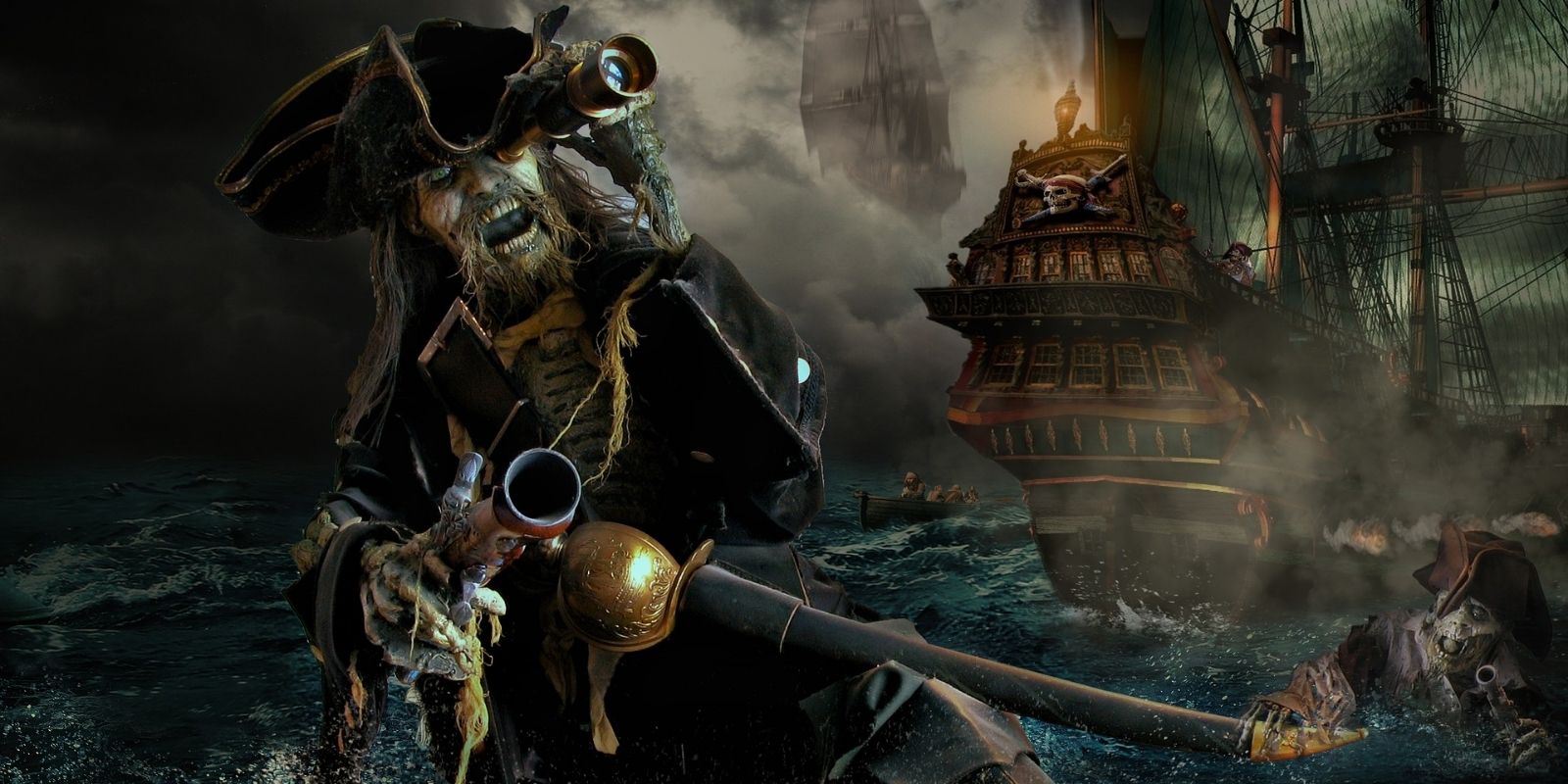Have you ever wondered about the pirate flag symbol? Is it legal to fly a pirate flag? or maybe you asked yourself, Why do pirate flags have a skull and crossbones? Have you heard about the jolly roger pirate flag? or Why did Pirates fly a black flag? And not a yellow one or a green one.
Whoever hears the pirate flag thinks of the color black, crossbones, and skulls—a typical pirate flag. But every pirate had its distinctive flag. In which, however, precisely these elements occur pretty often. After all, he wanted to spread fear and horror with his victims, which was most likely due to his reputation as a pirate.
Today we will answer all your questions about the pirate flag, and you will be surprised what this powerful symbol hides as a history and as a mystery until today.
Welcome to skull action, the place where enthusiasts like you do their best to bring you quality content. In this exciting article, we will spread out the whole history of the famous pirate flag, stay tuned because the sea is raging, we will see together :
- The different names of the pirate flag.
- The history behind the Jolly Joger
- The many appearances of this symbol in modern times
- The legend of the Blackbeard flag
But before we start, we invite you to discover our beautiful and unique pirate ring. Just click on the picture below.
Meaning of skull pirate flag
The pirate Emanuel Wynne used the famous skull and crossbones in the 18th century; An hourglass could still be seen under the skull on its red flag. This was supposed to signal to his victims that their time was up.
The pirate flag was red as blood as a symbol that the time of those who saw it now ended since the pirates who sailed under this flag knew no mercy. Prisoners should not be taken ☠️
More names for the pirate flag
The black pirate flag is also called the Jolly Roger. Another name for the black flag on pirate ships is, based on the British Union Jack, also Black Jack. Another name for the pirate flag beside Jolly Roger is the skull flag.
Jolly Roger
The origin of the name Jolly Roger for the black pirate flag is unknown. There are several attempts to explain it:
- Jolly Roger is a corruption of the name of the Indian pirate Ali Rajah. In the British’s ears, Ali Rajah sounded like Olly Roger, which led to Jolly Roger.
-
Another explanation tries French. Joli Rouge (pretty red), this is what the first blood-red flags that pirates hoisted looked like. And that is where Jolly Roger was born. -
In the Elizabethan Age (16th century, named after Queen Elizabeth I of England), Roger is said to have been a slang term for beggars and vagrants in England. Roger would then be Zealand tramps.
The term Jolly Roger for the pirate flag first appeared in a report from 1724. A Captain Charles Johnson (presumably a pseudonym) published A General History of the Pyrates and mentioned two pirates, Bartholomew Roberts and Francis Spriggs, who named their flag Jolly Roger. 🏴☠️
Both flags are said to have looked very different; as already mentioned, pirates preferred an unmistakable design to spread fear and terror, so Jolly Roger must have been the flag’s umbrella term. The book, which was published in Germany in 1728, contains biographies of well-known English pirates and has shaped pirates’ image.
Old Roger - the devil
Another possible explanation is that Jolly Roger is different from Old Rogera term for the devil derives. There is probably a report in a British weekly newspaper, the Weekly Journal or British Gazetter from October 19, 1723, which describes the sighting of a pirate ship off the West Indies.
According to the report, which describes an incident in July, the pirates hoisted a pirate flag with a portrait of death: the skeleton had an hourglass in one hand and an arrow in the other hand, plus a heart on it with three drops of blood.
According to the report, this flag would be called Old Roger and should make it clear that the pirates would live and die under it. Old became Jolly because the skull always looks like he's grinning.💀
History of the pirate flag
The exact origin for the use of the pirate flag is no longer known.
The first to have used a black flag with a skull as a pirate flag was allegedly Calico Jack Rackham (1682-1720, British). His crew included the two most famous female pirates, Anne Bonny and Mary Read. However, Jack Rackham's use of the pirate flag is not guaranteed. His flag is said to have shown two crossed cutlass in addition to a skull.🏴☠️
There is also a description of a skull flag from 1687 in a logbook. Here a pirate is described with a similar flag, but on land and not at sea. It is described in the entry that a white flag was laid down and instead, a red flag with a skull and two crossed bones were added and then the march was continued.
However, the Jolly Roger’s use with skull and two crossed bones by the Breton pirate Emanuel Wynne around the year 1700 is certain. A skull in front of two crossed bones and below the hourglass.
The pirate Edward Teach (Blackbeard) waved a flag that showed an entire skeleton and not just a skull. The skeleton has a lock-in its hand, aiming it at a bleeding heart. The skeleton has an hourglass in its hand, again a sign that the victims' time is up.
Further motifs on pirate flags
Other motifs on pirate flags were the forearm with a cutlass on the flag of Thomas Tews.
The pirate flag with a motif of skulls, bones, cutlass, or a whole skeleton is believed to have replaced the simple blood-red flag as a pirate symbol. The symbols for death were intended to instill fear and terror. Back then, a skull and crossbones were also common symbols used to mark a sailor’s death in logbooks.
Red flag as a pirate flag
Presumably, the pirates chose the red flag, as it was often used as a quarantine flag in the 16th and 17th centuries. She stood on board for a disease that could be fatal to the crew of the ships that were approaching. An approaching pirate ship often meant death for the crew of the other ships.
And since the danger of confusion was too great, the red flag was no longer hoisted alone on non-pirate ships but in conjunction with the swallowtail. In the Arabian Sea, the British Admiralty also insisted that some countries change their red flags to no longer be confused with pirate flags. And finally, the British Navy is said to have banned the use of only red flags in the Arabian Sea. Those sailing under a single red flag, were suspected of being pirate ships; they were also treated as pirates. 🚩
In 1694 the red flag was also made mandatory for British privateers. And when Great Britain was no longer at war with Spain from 1714 onwards, some pirates did not see why they should give up their trade and continued to sail under the red flag and now plundered British and no longer only Spanish ships.
Differentiation red and black pirate flag
Some pirates are said to have always had two pirate flags in their pastries. The red flag was hoisted when one did not want to take prisoners, and when the other side had to prepare for their Onen, the black flag was hoisted; the pirates were more eager for ransom. There is one report by an English captain Richard Hawkins from the 18th century describes this distinction between red and black flags. 🚩🏴
It should also have happened that a pirate ship first hoisted the black flag so that the enemy could surrender. If he resisted, the red flag was raised and the blood fought without mercy or consideration. This is what is reported at least from the 18th century.
Pirates today
Even today, pirates are a big problem in shipping. There are active pirates in Indonesia’s waters, in the Strait of Malacca and recently in the Arabian Sea. However, these pirates usually do without a pirate flag, after all, the moment of surprise during the attack is a decisive factor since it would not be helpful to identify yourself as a pirate too early.
Driving under a false flag
Even in the past, pirate ships did not always fly under their pirate flag. Various flags were carried on board. Usually, you camouflaged yourself with other flags to not attract attention too early or even to come across a stronger opponent.
The Jolly Rogers was only hoisted when the battle was imminent, the other ship could no longer escape the pirates and the battle was coming. When the enemy came within firing range, he was no longer left in the dark about his fate, the flag, which meant death and destruction, was now shown. Usually, a warning shot was fired with this notice.
Flying under a false flag was also a camouflage tactic used not only by pirates. The Algerian corsair Hamidu Reis became a victim of this false flag flying. An American warship hoisted the Union Jack in the Second Barbarian War.
However, the Algerian corsair had no dispute with Great Britain, and they found themselves in a state of war with the USA. Hamidu Reis did not notice the false flag, the Americans could approach unhindered and the corsair captain died in a naval battle off Cape Gata (Cabo de Gata, Almeria province, Spain).
The pirate flag miscellaneous
Peter Pan and the pirate ship
Author JM Barrie wrote the story of Peter Pan. It also includes Captain Hook, the antagonist of Peter Pan, the name of his pirate ship is Jolly Roger and the boat is painted in red and black colors.
FC St. Pauli
Fans of the Hamburg football club FC St. Pauli have been using a Jolly Roger since the mid-1980s. Initially, the pirate symbol was the unofficial club logo. Even if the club's coat of arms still shows a city gate, the black flag with a skull, crossbones, and FC St. Pauli lettering has become indispensable. The St. Pauli skull logo was also registered as a trademark in 1996.🏴☠️
Tampa Bay Buccaneers
FC St. Pauli is not the only sports club that uses the skull symbol as a logo. The Tampa Bay Buccaneers, a National Football League (NFL) American football team from Tampa, Florida, uses a skull with two crossed sabers and a football on it as their logo. The background of this skull symbol is crimson.
Dead pants
The Düsseldorf punk band Die Toten Hosen chose the bone eagle on a black background as their band logo in the mid-1980s.
Skull and Bones
The American student movement Skull & Bones, founded in 1832 at Yale University, uses skulls and crossbones in its logo. No wonder, after all, Skull & Bones means skulls and bones. The number 322 also belongs to the logo.
Independence Day
In the 1996 film Independence Day, David Levinson (Jeff Goldblum) flies to the alien mothership to infect it with a virus. The file that he uploads is called jollyroger.exe and shortly before the virus strikes, the image of a laughing skull and crossbones appears.
Red flags as pirate flags
Pirates were widespread in the Arabian Sea as early as the 19th century. These drove under a red pirate flag. This also resulted in the state of Bahrain being urged to change its originally completely red flag. At least in the opinion of the Royal Navy, the danger of confusing this national flag with the red pirate flag that prevailed in the Arabian Sea was too great. Bahrain added a white stripe to its red flag.
What you need to remember
The symbol of the pirates is still today the skull with crossed bones or cutlass. This flag is called "Jolly Roger.” Possibly the name derives from the term "Jolie Rouge", which French pirates are said to have used. Translated from French, this means "pretty red". In the beginning, many pirate flags were blood red. However, various theories about the origin of the word "Jolly Roger.” The flag was also called "Black Jack,” based on the Union Jack, the British flag.
The first flag with a skull was probably from the French pirate Emanuel Wynne around 1700. Not all pirate flags looked the same: some also showed whole skeletons or an hourglass, which was intended to signal the victims that their time was up. Other symbols such as arrow and spear symbolized a violent end, and a bleeding heart was meant to express a slow and cruel death.
The flags were not always used to deter opponents immediately. Many pirates only hoisted their skull flags after they had successfully boarded a ship. Before that, it was not uncommon for them to raise the "false flag" to deceive other ships. For example, they used the Union Jack to keep British ships safe. The flag was also intended to express contempt for the different national flags.
Famous pirate legends
The flag of the pirate Blackbeard shows a skeleton with a bleeding heart. It should symbolize a slow and cruel death. Incidentally, women were also on the move as a horror of the seas. They were officially forbidden to stay on pirate ships, but the Englishwoman Mary Read and the Irishwoman Anne Bonny, camouflaged in men's clothes, sailed as pirates across the oceans. They were considered fearless and particularly cruel.
Another famous pirate was Francis Drake, who lived in the 16th century. The dreaded pirate attacked Spanish ships that were loaded with treasures from America. In almost three years, he became the first Englishman to sail around the world. He was even knighted by Queen Elisabeth I, the then Queen of England: Sir Francis Drake fought from now on behalf of the English crown against the Spanish fleet.
A particularly notorious and cruel pirate was the Englishman Blackbeard (meaning: "Black Beard"), who made the Caribbean Sea unsafe at the beginning of the 18th century. He, too, was eventually beheaded, and his opponents hung his head on the ship’s bow. Legend has it that Blackbeard also performed a miracle after his death: his body is said to have swum several laps around the ship before it sank. The famous buccaneer's boat was discovered in North Carolina in 1996 and can be admired as a tourist attraction.🏝
The horrors of the seas still exist today. The infamous pirate Blackbeard was executed in 1718. His opponents hung his decapitated head from the bow of the ship.
Pirate legends were passed on and embellished more and the centuries. Many pirates were turned into true heroes and their lives were romantically decorated. Or they have portrayed as particularly cruel and creepy horror stories created - like the legend about the pirate Blackbeard’s execution.
Countless pirate films are also about brave buccaneers and the adventurous life of the "Lords of the Seven Seas". The "heroic motives" of most pirates were nothing more than greed. Even sailors who otherwise couldn't find work were hired on pirate ships. Some buccaneers were held in high esteem for acting on behalf of their governments, helping them to build wealth and power.
Pirates still exist today. However, they do without the flags of the earlier pirates. Off the coasts of some African and Asian countries, pirates repeatedly attack foreign ships and earn their money by selling the booty. Sometimes they kidnap members of the ship's crew to extort ransom for them. In 2004, 325 pirate attacks were reported.
Thirty people were killed. Poverty plays a significant role in countries like Somalia. Many children do not have the opportunity to go to school - and more and more young people are joining the pirates.
Are you ready to raise the black flag?
If you're still reading this, you've been holding on tightly to the rope even with the storm, and you’re not just anyone! 🙏
We were able to go through the whole history of the pirate flag together. The latter will no longer hold any secrets for you. Deep down, you know it, and you’ll never look at a pirate flag the same way again. Maybe you'll even buy one for next Halloween.
The pirates’ days are long gone, but the Jolly Jager’s symbol will live on and is still used by pirates in the digital world today. Piracy will always exist; it is part of human nature.
If you are passionate about pirate symbols, we invite you to visit our store; we have lots of surprises for you in clothes, accessories, jewelry, and even flags. Click on the image below and treat yourself.



